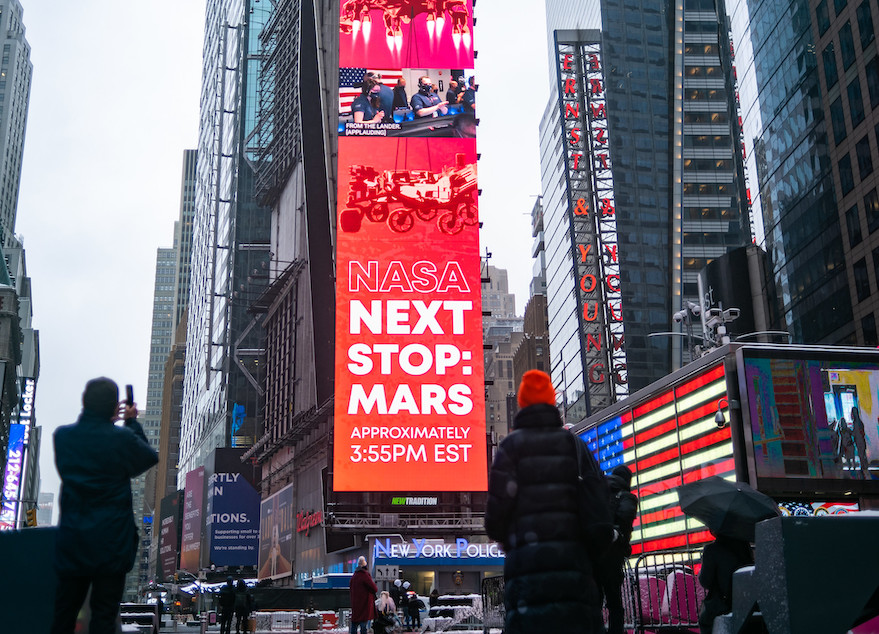Products You May Like
The key is developing a 10-ton lander
The triumphant landing of the Perseverance rover has inspired all Americans, and indeed much of the world. President Biden should follow it up by launching the program to send humans to Mars.
While robotic rovers are wonderful, they cannot resolve the fundamental scientific questions that Mars poses to humanity, which relate to the potential prevalence and diversity of life in the universe. The early Mars was very much like the early Earth; a rocky warm and wet planet with a carbon dioxide dominated atmosphere. Life appeared on Earth virtually as soon as our planet was cool enough for liquid water.
- Did it appear on Mars, too?
- If so, did it use the same DNA-RNA information system underlying all life on Earth, or something else?
- We now know that billions of stars have planets. Is life likely to be found everywhere?
- Is life as we know it on Earth what life is? Or is it just a particular example drawn from a vast tapestry of possibilities?
These are questions that thinking men and women have wondered about for thousands of years. They can only be resolved by sending humans to Mars.
Finding evidence of past life requires fossil hunting. Perseverance will make a stab at that, but human rockhounds, capable of traveling far over difficult terrain, climbing, digging, doing delicate work, and intuitively following up clues can do that job vastly better. Finding extant life to determine its nature will require drilling down hundreds of meters to reach underground water where life might still thrive, bringing up samples, culturing them, and subjecting them to analysis. That is light years beyond the ability of robotic rovers.
If we don’t go, we won’t know.
Some say that sending humans to Mars is a task for the far future, far beyond our abilities. In fact, the means to do such a mission are close at hand.
Sending humans to Mars does not require building gigantic multi megawatt ion drive science fiction spaceships in a futuristic world of orbital spaceports. It requires sending a payload of 10 tons or more capable of supporting a small group of people from Earth to Mars, landing it, and then sending that or a comparable payload back.
The currently operational SpaceX Falcon Heavy could throw a 10-ton class lander to Mars. The soon-to-be-operational NASA SLS and SpaceX Starship booster will be able to send a 20-ton lander. So we have that part covered. The next thing we need is the lander.
The Perseverance landing system can deliver one ton to the surface of Mars. To get started with human exploration, we need a 10-ton class lander. There are a number of ways to create such a system. For example, we could use aeroshells, parachutes and landing jets, or perhaps a miniature version of Starship. I won’t go into the details. But the bottom line is if we can land one ton on Mars we can land 10. It requires no scientific breakthroughs, just engineering.
Once we have a 10-ton lander, we can use it to send large robotic expeditions to Mars. Instead of landing one rover, we land a platoon of robots. These could include science explorers like Perseverance, and much bigger versions of the Ingenuity helicopter capable of wide-ranging reconnaissance. Smaller rovers armed with high-resolution cameras could create a high-definition map of the area, transmit to Earth, to allow millions of people here walk the landscape with virtual reality gear, directly assisting the robots in exploration by calling their attention to features of interest.
But the expedition would also include construction robots, possibly humanoid in form with arms and legs, capable of building a Mars base. These would set up a power system, and put in operation units for converting Martian carbon dioxide and water ice into methane and oxygen rocket propellant, and store it in tanks. With such a base set up and fully equipped with housing, power, a well-instrumented lab, a workshop, and supplies in advance, all astronauts will need to do is show up with a credit card, and check in. Everything they need to live and work on Mars, and return from Mars, will be there waiting for them.
Now is the time
There is nothing in this plan that is beyond our capability, either technically or financially. Instead of wasting decades building a random assortment of very expensive space stations in various orbits and attempting to justify them with the rationale that they might someday be useful if we ever decide to send humans to Mars, this approach tackles the central challenges facing human Mars missions head on while greatly enhancing our scientific exploration capability immediately. By embracing it, Joe Biden could take the key step that would allow America to once again astonish the world with what free people can do. The COVID-19 pandemic has shown the importance of science to our lives. Science comes from scientists, who come from children who want to become scientists. Youth loves adventure. As it did during the Apollo days, a bold space program would make science a great adventure, inspiring millions of young people to want to become scientists, engineers, inventors, medical researchers, and technological entrepreneurs — the ultimate resource we will need to meet whatever challenges the future may bring.
Seize the time, Joe.
Robert Zubrin, @robert_zubrin an aerospace engineer, is the founder of the Mars Society and the president of Pioneer Astronautics. He is the author of “The Case for Mars: The Plan to Settle the Red Planet and Why We Must,” published by Simon and Schuster.
